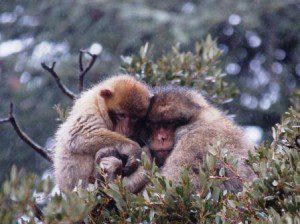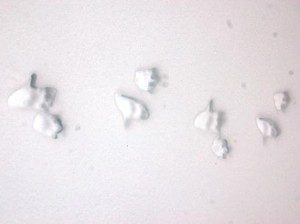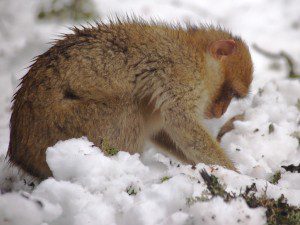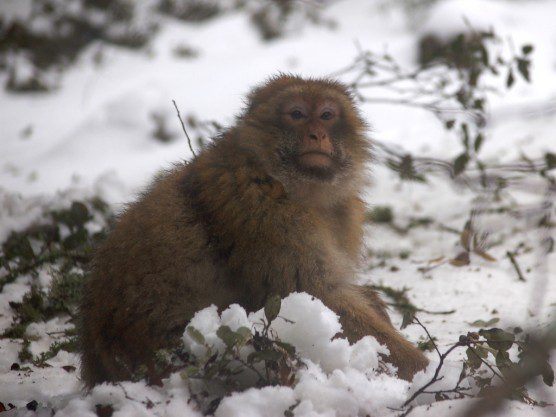Barbary macaques, Africa’s own snow monkeys

When you see pictures of monkeys frolicking in the snow, you’re usually looking at photos of Japanese macaques. The species is famous for taking a break from the winter’s cold by basking in natural hot springs.
Now Keri Cairns, IPPL’s roving representative zoologist, introduces us to Africa’s version of the snow monkey. Barbary macaques, too, are at home in a colder climate: they’re native to the mountain forests of Algeria and Morocco.

Wild Barbary macaques huddle for warmth in their snowy mountain home.
Keri has seen these monkeys travel and forage in frigid conditions. He has spent days tracking their footprints, sometimes slogging through two feet of snow. Once he even found jackal scat with monkey fur in it.

Macaque tracks in the snow.

A captive Barbary macaque in Marrakech.
Last week Keri gave us a glimpse of what life is like for captive Barbary macaques in their home country of Morocco: baby monkeys of this endangered species are routinely snatched from the wild and forced to perform for tourists in the squares of Marrakech and elsewhere. It’s a grim life for these remarkable animals.
This week Keri has sent us something completely different: Barbary macaques in nature, as they were meant to be. He has been doing some arduous mountain trekking in order to catch of glimpse of real wild Barbary macaques. “I’m off up my third mountain range in as many weeks! Show me the monkeys!” he wrote last week. With the help of Ahmed El Harrad, deputy director of the nonprofit monkey advocacy organization Barbary Macaque Conservation in the Rif (BMCRif), I think Keri now feels fully initiated into the clan of the “Mad Mountainous Moroccan Monkey Men” (as he puts it).

A Barbary macaque forages in the snow near Azrou.
Sadly, there are only a few thousand of these monkeys left. Not only are they trapped to entertain tourists and for the illegal pet trade, their native habitat is under threat. Earlier this week, Keri reported that he had seen “another two mountains with monkeys and, I’m sad to say, several mountains that are no more. In the last seven years some international companies have blown them to pieces and sent the stones around the world for construction!”
Illegal logging of the animals’ native cedar, oak, and pine forests is another concern. Last week, while staying in the small Moroccan city of Azrou about 50 miles south of Fez, Keri wrote to us that he had been observing “a truck drive out of the cedar forest every day with large, ancient cedar trunks on it.”

The dwindling populations of wild Barbary macaques are desperately in need of allies.
Keri will soon be heading home to England to sort out his thousands of photos and write up some final reports for us. But he has made some good friends during his stay among Africa’s snow monkeys. As he says, “we now have eyes and ears in Morocco.”


The last photo is of a macaque named Shirley! Named in honour of IPPL founder Shirley McGreal. ;o)
Wonderful! She definitely looks like the boss of her troop!
thank you for all of your hard work concerning primates.
marianne
I used to do benign research on the intelligence of two Barbary macaques in my lab at San Diego State University. Now that I’m retired, I visit at least one of the four Barbary Macaque nature parks, owned by Gilbert de Turkheim, every few years. They are located in Kintzheim, Alsace, France, Rocamadour, Lot, France, Salem Affenberg near Lake Konstanz, Germany, and Trentham near Stoke-on-Trent in the UK. At my flickr site you will find scores of photos of Barbary macaques from my October 2012 visit to Kintzheim (La montagne des singes) and Salem Affenberg.